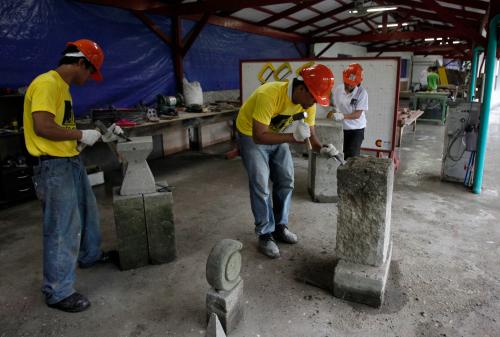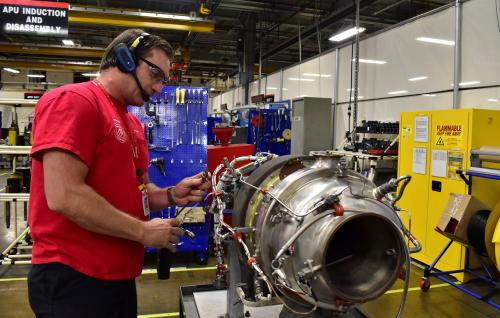In the transition away from No Child Left Behind, there has been a parallel resurgence of interest in career and technical education (CTE) as an alternative pathway for K-12 students. In 2015, the most recent evidence available, more than 7 million secondary school students and nearly 4 million postsecondary students were enrolled in CTE programming. In 2018, the Carl D. Perkins Career and Technical Education Act was reauthorized, providing $1.2 billion in funding for CTE programs and job training for students.
As noted by Jacob (2017), proponents of CTE argue that such programming improves career opportunities by providing students with hands-on training and the soft skills necessary to succeed in the labor market. Similarly, advocates stress that CTE may improve core academic skills by fostering student engagement and motivating students to attend school more regularly. Cullen et al. (2013), in their recommendations for improving failing schools, argue for an increased focus on vocational training such as CTE as a way to foster practical skills and labor market integration. Nevertheless, despite the resurgence of interest in CTE, there is limited evidence on the effectiveness of CTE as an alternative pathway for K-12 students.
What does existing evidence suggest about the efficacy of CTE?
Answers around the success of CTE have eluded researchers for a long time. A primary challenge in identifying the effects of CTE programs is the fact that students who choose to pursue CTE are usually different in important ways from those who do not. Therefore, without some source of experimental variation, it is not possible to identify the effects of CTE programs independent of other factors like student motivation. Yet new research has begun to disentangle this relationship; we describe below some of the few studies that provide evidence of the causal impact of CTE on student outcomes.
What little high quality causal evidence exists has all been conducted on smaller scales that inhibit our ability to understand what to expect from CTE systems operating at scale. Earlier experimental work on career academies, one model of career-themed curricula that create schools within schools, suggested that participation in themed CTE programs in high schools improved earnings in the first seven years after high school. More recent work suggests that career academies may also improve high school completion. Though both of these studies are excellent in terms of their support of causal inference, they included nine schools and one school respectively. Similarly, there is some evidence that whole-school models can enhance high school completion with no change in test scores; in this study, however, only three schools were included in the most internally valid estimates. Since each of these prior studies include so few schools, there is reason to be concerned that perhaps these individual schools are anomalies and not representative of a model that could be impactful at scale.
Critics of CTE also point out that the emphasis on vocational skills in one particular field poses a long-term risk to workers who may experience job loss. If the job for which they trained ends or moves, workers will be displaced and may not have an adaptable set of skills to apply to a new line of work. This criticism assumes that technical/vocational skills are substitutes for general learning (reading, writing, and math). Although evidence of the long-term effects of attending a CTE program remains limited, there is increasing evidence that high-quality CTE programs in high school are actually complements—they can improve high school completion, employment, and earnings, all while not sacrificing general learning outcomes.
Updating the evidence: Positive impacts for boys from CTE at scale
We studied a statewide system of CTE high schools operating at scale in Connecticut. Specifically, we estimated the impact of attending high school in one of 16 CTE-focused high schools in the Connecticut Technical High School System (CTHSS), a quasi-independent school district of choice serving students across the entire state. These schools are popular—more students apply than can be admitted. Students apply to schools and their middle-school test scores, attendance, and discipline data (in the cohorts for whom we have the most years of data) are used to create a composite application score. These scores are then rank ordered and used to admit students in descending order until all available slots are filled. Thus, we exploit the use of a well-defined application score for admission to estimate the effects of just getting into one of the technical high schools, relative to just missing admission.
We found that the impacts of admission and participating in one of the high schools in the CTHSS system accrue entirely to male students. We found that male students who were admitted and attended a CTHSS had (relative to otherwise identical males who just missed admission and did not attend):
- Better 9th-grade attendance rates (by 14%)
- Better 10th-grade test scores (by 0.2 standard deviations)
- Higher graduation rates (by 10 percentage points)
- Higher quarterly earnings at age 23 (by 30%)
- No differences in college attendance by age 23.
Our evaluation included all schools within the system that were operating during the years of the study, and the system educates approximately 8% of all high school students in the state. Our study demonstrates that stand-alone, CTE-focused schools can be successfully offered at scale, having a large impact on both the educational and early labor market success of young men. It is notable that we observed improvements in 10th-grade test scores, suggesting that attending one of the CTHSS high schools also contributed to the acquisition of general skills.
The effects for female students were near zero for both educational and labor market outcomes and were relatively precisely estimated. The data do not allow us to determine what mechanism might account for these differences, however, there are clear differences in the types of programs that males and females select into, suggesting that future work might explore within-program effects. Other than gender differences, the effects were relatively broad based, extending to cities and non-cities, higher- and lower-income students, and all race/ethnicity designations in the data. While our estimates only uncover the effects for students near the admissions threshold, the thresholds vary substantially over time and across schools, providing a sample that characterizes program impacts over a wide range of students’ previous academic performance.
What mechanisms generate impacts?
The school experience in CTHSS is notably different compared to residentially assigned schools. CTHSS students take CTE coursework instead of other electives during high school (think fewer world language or music courses). Typically, CTE coursework is grouped into one of 10 to 17 programs of study, such as information technology, health services, cosmetology, heating ventilation and air conditioning, and production processes, among others. Students explore various programs of study during their first year, selecting a final program of study at the end of that year in consultation with an adviser. Within these programs, students will take at least three (often more) courses focused on their program of study. Traditional high schools in the state tend to offer both fewer programs and courses, and often students face substantial limitations in their ability to pursue advanced material in their program of interest. Additionally, CTHSS schools often align academic coursework with CTE and offer other work-based learning opportunities, both within and outside of school, which likely enhances the complementarity between both the vocational and academic learning.
We conducted a counterfactual analysis where we examined whether the positive effects of attendance at a CTHSS school was concentrated among students whose home high school had fewer CTE offerings. We found that both the effects on high school graduation and quarterly earnings were larger when the home high school provided limited CTE opportunities. However, these differences were relatively small; simply having more options and courses at CTHSS schools can only explain, at most, one-third of the benefits provided by those schools. These findings suggest that most of our estimated effects arise from the unique experiences provided by receiving CTE in a stand-alone school dedicated to providing CTE.
Implications for policymakers
Our findings add to earlier work that suggests that whole-school models of CTE can benefit students both academically and in terms of their workforce outcomes. Thus, as CTE continues to be a focus of education policy, policymakers would be wise to consider what models of CTE are being scaled and what investments are being induced. A large share of the funds under the Carl D. Perkins Career and Technical Education Act are allocated to within-school programs. Without a better understanding of the factors that lead to the large positive effects of stand-alone CTE schools, high schools have little guidance about how to allocate additional Perkins funds as they expand their CTE programming. Also, prior to our study, the literature has provided virtually no evidence of the effectiveness of CTE specifically for female students. Our inability to detect any positive effects for female students suggests a need for future research in order to understand the types of CTE programming that might be more useful and engaging for high school girls.






Commentary
The promise of career and technical education
September 20, 2019